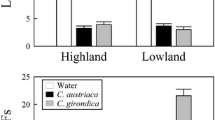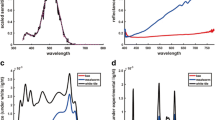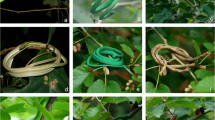Abstract
The ability of hatchling pine snakes (Pituophis melanoleucus) to follow or avoid the chemical trails of conspecifics and a king snake (Lampropeltis getulus) on paper substrates was investigated inY-maze experiments. Hatchlings entered the arm with the adult conspecific trail and avoided the arm containing the king snake trail at a frequency much greater than that due to chance. The data support the hypotheses that pine snakes follow the chemical trails of adult conspecifics and avoid the chemical trails of a predator.
Similar content being viewed by others
References
Aleksuik, M. 1976. Reptilian hibernation: Evidence of adaptive strategies inThamnophis sirtalis parietalis.Copeia 1976:170–178.
Brown, W.S., andMaclean, F.M. 1983. Conspecific scent-trailing by newborn timber rattle-snakes,Crotalus horridus.Herpetologica 39:430–436.
Brown, W.S., Parker, W.S., andElder, J.A. 1974. Thermal and spatial relationships of two species of colebrid snakes during hibernation.Herpetologica 30:32–38.
Burger, J., andGochfeld, M. 1985. Behavioral development: Nest emergence of young pine snakes (Pituophis melanoleucus).J. Comp. Psychol. 99j:150–159.
Burger, J., Zappalorti, R.T., Gochfeld, M., Boarman, W.I., Caffrey, M., Doig, V., Garber, S.D., Lauro, B., Mikovsky, M., Safina, C., andSaliva, J. 1988. Hibernacula and summer den sites of pine snakes (Pituophis melanoleucus) in the New Jersey Pine Barrens.J. Herpetol. 22:425–433.
Burghardt, G.M. 1973. Chemical release of prey attack: Extension to naive newly hatched lizards,Eumeces fasciatus.Copeia 1973:178–181.
Burghardt, G.M. 1980. Behavioral and stimulus correlates of vomeronasal functioning in reptiles: Feeding, grouping, sex, and tongue use, pp. 275–301,in D. Muller-Scwarze, and R.M. Silverstein (eds.). Chemical Signals in Vertebrates and Aquatic Invertebrates. Plenum Press, New York.
Burghardt, G.M. 1983. Aggregation and species discrimination in newborn snakes.Z. Tierpsychol. 61:89–101.
Carpenter, C.C., andGillingham, J.C. 1975. Postural responses to king snakes by crotaline snakes.Herpetologica 31:293–302.
Chiszar, D., Scudder, K., Knight, L., andSmith, H.M. 1978. Exploratory behavior in prairie rattlesnakes (Crotalis viridis) and water moccasins (Agkistrodon piscivorus).Psychol. Rec. 28:363–368.
Chiszar, D., Radcliff, C., Boyd, R., Radcliff, A., Yun, H., Smith, H.M., Boyer, R., Atkins, B., andFeiler, F. 1986. Trailing behavior in cottonmouths (Agkistrodon piscivorus).J. Herpetol. 20:269–272.
Cooper, W.E., andVitt, L.J. 1984. Detection of conspecific odors by the female broad-headed skink,Eumeces laticeps.J. Exp. Zool. 229:49–54.
Cooper, W.E., andVitt, L.J. 1986a. Tracking of female conspecific odor trails by male broad-headed skinks (Eumeces laticeps).Ethology 71:242–248.
Cooper, W.E., andVitt, L.J. 1986b. Interspecific odour discrimination by a lizard (Eumeces laticeps).Anim. Behav. 34:367–376.
Cooper, W.E., andVitt, L.J. 1986c. Interspecific odour discriminations among syntopic congeners in scincid lizards (GenusEumeces).Behaviour 97:1–9.
Cooper, W.E., Garstka, W.R., andVitt, L.J. 1986. Female sex pheromone in the lizardEumeces laticeps.Herpetologica 42:361–366.
Ditmars, R.I. 1935. Serpents of the Northeastern States. NY Zoological Society, New York, New York 40 pp.
Fitch, H.S. 1960. Criteria for determining sex and breeding maturity in snakes.Herpetologica 16:49–51.
Fitch, H.S. 1963. Natural History of the RacerColuber constrictor. University of Kansas, Publ. No. 15, pp. 351–468.
Ford, N.B. 1982. Species specificity of sex pheromone trails of sympatric and allopatric garter snakes (Thamnophis).Copeia 1982:10–13.
Ford, N.B., andO'bleness, M.L. 1986. Species and sexual specificity of pheromone trails of the garter snake,Thamnophis marcianus.J. Herpetol. 20:259–262.
Ford, N.B., andSchofield, C.W. 1984. Species specificity of sex pheromone trails in the plains garter snake,Thamnophis radix.Herpetologica 40:51–55.
Gehlbach, F.R., Watkins, J., andKroll, J. 1971. Pheromone trail following studies of typhlopid, leptotyphlopid, and colubrid snakes.Behaviour 40:282–294.
Gregory, P.T. 1983. Identification of sex of small snakes in the field.Herpetol. Rev. 14:42–43.
Gutzke, Paukstis, G.L., andMcdanial, L.L. 1985. Skewed sex ratios for adult and hatchling bullsnakes,Pituophis melanoleucus, in Nebraska.Copeia 1985:649–652.
Heller, S., andHalpern, M. 1981. Laboratory observations on conspecific and congeneric scent trailing in garter snakes (Thamnophis).Behav. Neural. Biol. 33:372–377.
Klauber, L.M. 1972. Rattlesnakes, Their Habits, Life Histories and Influence on Mankind, Vol. 2. University of California Press, Berkeley.
Marchisin, A. 1980. Predator-prey interactions between snake-eating snakes. Unpublished PhD dissertation, Rutgers University, New Brunswick, New Jersey.
Parker, W.S., andBrown, W.S. 1973. Species composition and population changes in two complexes of snake hibemacula in northern Utah.Herpetologica 29:319–326.
Schaefer, W.H. 1934. Diagnosis of sex in snakes.Copeia 1934:181.
Simon, C.A. 1983. A review of lizard chemoreception, pp. 119–133,in R.B. Huey, E.R. Pianka, and T.W. Schoener (eds.). Lizard Ecology: Studies of a Model Organism. Harvard University Press, Cambridge.
Thoen, C., Bauwens, D., andVerkeyen, R.F. 1986. Chemoreceptive and behavioral responses of the common lizardLacerta vivipara to snake chemical deposits.Anim. Behav. 34:1805–1813.
Von Achen, P.H., andRakestraw, J.L. 1984. The role of chemoreception in the prey selection of neonate reptiles,in A Tribute to Harry S. Fitch. R.A. Seigel, L.E. Hunt, J.L. Knight, L. Malaret, and N.L. Zuschlag (eds.). Vertebrate Ecology and Systematics—Museum of Natural History, University of Kansas, Lawrence, Kansas.
Weldon, P.J. 1982. Responses to ophiophagous snakes by snakes of the genusThamnophis.Copeia 1982:788–794.
Weldon, P.J., andBurghardt, G.M. 1979. The ophiophage defensive response in crotaline snakes: Extension to new taxa.J. Chem. Ecol. 5:141–151.
Author information
Authors and Affiliations
Rights and permissions
About this article
Cite this article
Burger, J. Following of conspecific and avoidance of predator chemical cues by pine snakes (Pituophis melanoleucus). J Chem Ecol 15, 799–806 (1989). https://doi.org/10.1007/BF01015178
Received:
Accepted:
Issue Date:
DOI: https://doi.org/10.1007/BF01015178




